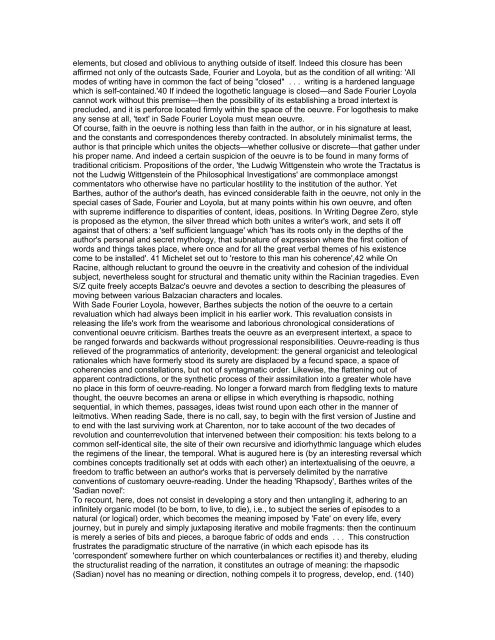You also want an ePaper? Increase the reach of your titles
YUMPU automatically turns print PDFs into web optimized ePapers that Google loves.
elements, but closed <strong>and</strong> oblivious to anyth<strong>in</strong>g outside <strong>of</strong> itself. Indeed this closure has been<br />
affirmed not only <strong>of</strong> <strong>the</strong> outcasts Sade, Fourier <strong>and</strong> Loyola, but as <strong>the</strong> condition <strong>of</strong> all writ<strong>in</strong>g: 'All<br />
modes <strong>of</strong> writ<strong>in</strong>g have <strong>in</strong> common <strong>the</strong> fact <strong>of</strong> be<strong>in</strong>g "closed" . . . writ<strong>in</strong>g is a hardened language<br />
which is self-conta<strong>in</strong>ed.'40 If <strong>in</strong>deed <strong>the</strong> logo<strong>the</strong>tic language is closed—<strong>and</strong> Sade Fourier Loyola<br />
cannot work without this premise—<strong>the</strong>n <strong>the</strong> possibility <strong>of</strong> its establish<strong>in</strong>g a broad <strong>in</strong>tertext is<br />
precluded, <strong>and</strong> it is perforce located firmly with<strong>in</strong> <strong>the</strong> space <strong>of</strong> <strong>the</strong> oeuvre. For logo<strong>the</strong>sis to make<br />
any sense at all, 'text' <strong>in</strong> Sade Fourier Loyola must mean oeuvre.<br />
Of course, faith <strong>in</strong> <strong>the</strong> oeuvre is noth<strong>in</strong>g less than faith <strong>in</strong> <strong>the</strong> author, or <strong>in</strong> his signature at least,<br />
<strong>and</strong> <strong>the</strong> constants <strong>and</strong> correspondences <strong>the</strong>reby contracted. In absolutely m<strong>in</strong>imalist terms, <strong>the</strong><br />
author is that pr<strong>in</strong>ciple which unites <strong>the</strong> objects—whe<strong>the</strong>r collusive or discrete—that ga<strong>the</strong>r under<br />
his proper name. And <strong>in</strong>deed a certa<strong>in</strong> suspicion <strong>of</strong> <strong>the</strong> oeuvre is to be found <strong>in</strong> many forms <strong>of</strong><br />
traditional criticism. Propositions <strong>of</strong> <strong>the</strong> order, '<strong>the</strong> Ludwig Wittgenste<strong>in</strong> who wrote <strong>the</strong> Tractatus is<br />
not <strong>the</strong> Ludwig Wittgenste<strong>in</strong> <strong>of</strong> <strong>the</strong> Philosophical Investigations' are commonplace amongst<br />
commentators who o<strong>the</strong>rwise have no particular hostility to <strong>the</strong> <strong>in</strong>stitution <strong>of</strong> <strong>the</strong> author. Yet<br />
Bar<strong>the</strong>s, author <strong>of</strong> <strong>the</strong> author's death, has ev<strong>in</strong>ced considerable faith <strong>in</strong> <strong>the</strong> oeuvre, not only <strong>in</strong> <strong>the</strong><br />
special cases <strong>of</strong> Sade, Fourier <strong>and</strong> Loyola, but at many po<strong>in</strong>ts with<strong>in</strong> his own oeuvre, <strong>and</strong> <strong>of</strong>ten<br />
with supreme <strong>in</strong>difference to disparities <strong>of</strong> content, ideas, positions. In Writ<strong>in</strong>g Degree Zero, style<br />
is proposed as <strong>the</strong> etymon, <strong>the</strong> silver thread which both unites a writer's work, <strong>and</strong> sets it <strong>of</strong>f<br />
aga<strong>in</strong>st that <strong>of</strong> o<strong>the</strong>rs: a 'self sufficient language' which 'has its roots only <strong>in</strong> <strong>the</strong> depths <strong>of</strong> <strong>the</strong><br />
author's personal <strong>and</strong> secret mythology, that subnature <strong>of</strong> expression where <strong>the</strong> first coition <strong>of</strong><br />
words <strong>and</strong> th<strong>in</strong>gs takes place, where once <strong>and</strong> for all <strong>the</strong> great verbal <strong>the</strong>mes <strong>of</strong> his existence<br />
come to be <strong>in</strong>stalled'. 41 Michelet set out to 'restore to this man his coherence',42 while On<br />
Rac<strong>in</strong>e, although reluctant to ground <strong>the</strong> oeuvre <strong>in</strong> <strong>the</strong> creativity <strong>and</strong> cohesion <strong>of</strong> <strong>the</strong> <strong>in</strong>dividual<br />
subject, never<strong>the</strong>less sought for structural <strong>and</strong> <strong>the</strong>matic unity with<strong>in</strong> <strong>the</strong> Rac<strong>in</strong>ian tragedies. Even<br />
S/Z quite freely accepts Balzac's oeuvre <strong>and</strong> devotes a section to describ<strong>in</strong>g <strong>the</strong> pleasures <strong>of</strong><br />
mov<strong>in</strong>g between various Balzacian characters <strong>and</strong> locales.<br />
With Sade Fourier Loyola, however, Bar<strong>the</strong>s subjects <strong>the</strong> notion <strong>of</strong> <strong>the</strong> oeuvre to a certa<strong>in</strong><br />
revaluation which had always been implicit <strong>in</strong> his earlier work. This revaluation consists <strong>in</strong><br />
releas<strong>in</strong>g <strong>the</strong> life's work from <strong>the</strong> wearisome <strong>and</strong> laborious chronological considerations <strong>of</strong><br />
conventional oeuvre criticism. Bar<strong>the</strong>s treats <strong>the</strong> oeuvre as an everpresent <strong>in</strong>tertext, a space to<br />
be ranged forwards <strong>and</strong> backwards without progressional responsibilities. Oeuvre-read<strong>in</strong>g is thus<br />
relieved <strong>of</strong> <strong>the</strong> programmatics <strong>of</strong> anteriority, development: <strong>the</strong> general organicist <strong>and</strong> teleological<br />
rationales which have formerly stood its surety are displaced by a fecund space, a space <strong>of</strong><br />
coherencies <strong>and</strong> constellations, but not <strong>of</strong> syntagmatic order. Likewise, <strong>the</strong> flatten<strong>in</strong>g out <strong>of</strong><br />
apparent contradictions, or <strong>the</strong> syn<strong>the</strong>tic process <strong>of</strong> <strong>the</strong>ir assimilation <strong>in</strong>to a greater whole have<br />
no place <strong>in</strong> this form <strong>of</strong> oeuvre-read<strong>in</strong>g. No longer a forward march from fledgl<strong>in</strong>g texts to mature<br />
thought, <strong>the</strong> oeuvre becomes an arena or ellipse <strong>in</strong> which everyth<strong>in</strong>g is rhapsodic, noth<strong>in</strong>g<br />
sequential, <strong>in</strong> which <strong>the</strong>mes, passages, ideas twist round upon each o<strong>the</strong>r <strong>in</strong> <strong>the</strong> manner <strong>of</strong><br />
leitmotivs. When read<strong>in</strong>g Sade, <strong>the</strong>re is no call, say, to beg<strong>in</strong> with <strong>the</strong> first version <strong>of</strong> Just<strong>in</strong>e <strong>and</strong><br />
to end with <strong>the</strong> last surviv<strong>in</strong>g work at Charenton, nor to take account <strong>of</strong> <strong>the</strong> two decades <strong>of</strong><br />
revolution <strong>and</strong> counterrevolution that <strong>in</strong>tervened between <strong>the</strong>ir composition: his texts belong to a<br />
common self-identical site, <strong>the</strong> site <strong>of</strong> <strong>the</strong>ir own recursive <strong>and</strong> idiorhythmic language which eludes<br />
<strong>the</strong> regimens <strong>of</strong> <strong>the</strong> l<strong>in</strong>ear, <strong>the</strong> temporal. What is augured here is (by an <strong>in</strong>terest<strong>in</strong>g reversal which<br />
comb<strong>in</strong>es concepts traditionally set at odds with each o<strong>the</strong>r) an <strong>in</strong>tertextualis<strong>in</strong>g <strong>of</strong> <strong>the</strong> oeuvre, a<br />
freedom to traffic between an author's works that is perversely delimited by <strong>the</strong> narrative<br />
conventions <strong>of</strong> customary oeuvre-read<strong>in</strong>g. Under <strong>the</strong> head<strong>in</strong>g 'Rhapsody', Bar<strong>the</strong>s writes <strong>of</strong> <strong>the</strong><br />
'Sadian novel':<br />
To recount, here, does not consist <strong>in</strong> develop<strong>in</strong>g a story <strong>and</strong> <strong>the</strong>n untangl<strong>in</strong>g it, adher<strong>in</strong>g to an<br />
<strong>in</strong>f<strong>in</strong>itely organic model (to be born, to live, to die), i.e., to subject <strong>the</strong> series <strong>of</strong> episodes to a<br />
natural (or logical) order, which becomes <strong>the</strong> mean<strong>in</strong>g imposed by 'Fate' on every life, every<br />
journey, but <strong>in</strong> purely <strong>and</strong> simply juxtapos<strong>in</strong>g iterative <strong>and</strong> mobile fragments: <strong>the</strong>n <strong>the</strong> cont<strong>in</strong>uum<br />
is merely a series <strong>of</strong> bits <strong>and</strong> pieces, a baroque fabric <strong>of</strong> odds <strong>and</strong> ends . . . This construction<br />
frustrates <strong>the</strong> paradigmatic structure <strong>of</strong> <strong>the</strong> narrative (<strong>in</strong> which each episode has its<br />
'correspondent' somewhere fur<strong>the</strong>r on which counterbalances or rectifies it) <strong>and</strong> <strong>the</strong>reby, elud<strong>in</strong>g<br />
<strong>the</strong> structuralist read<strong>in</strong>g <strong>of</strong> <strong>the</strong> narration, it constitutes an outrage <strong>of</strong> mean<strong>in</strong>g: <strong>the</strong> rhapsodic<br />
(Sadian) novel has no mean<strong>in</strong>g or direction, noth<strong>in</strong>g compels it to progress, develop, end. (140)


















